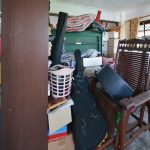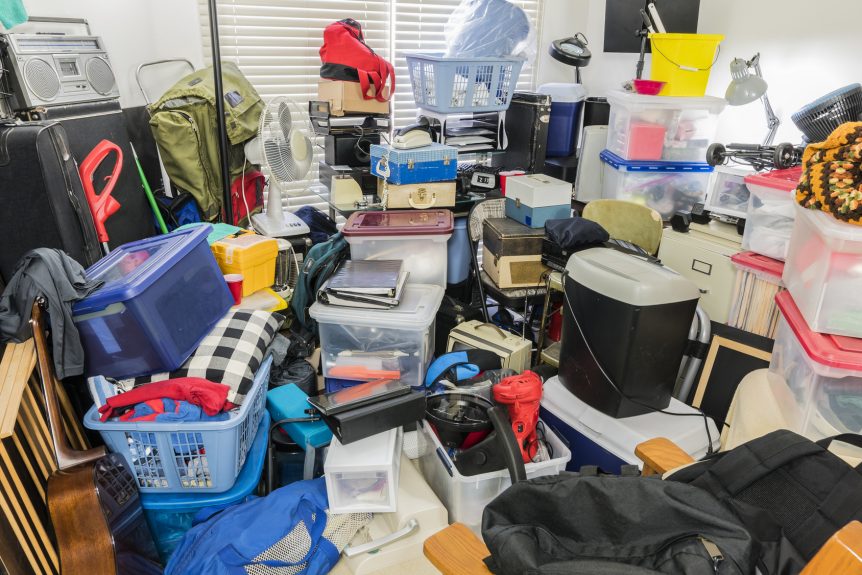Hoarding involves compulsively finding and keeping objects that have no real use or value. Hoarders commonly keep items like trash, newspapers, animals, boxes, food, clothes, plastic and paper bags, electronics, and appliances. This condition can be much more serious than some clutter around the house and depending on how extreme a person’s condition is, it can affect their emotional and physical health, relationships, and aspirations.
Hoarding disorders have many different types and stages, which makes it difficult to identify how serious a person’s condition is. The National Study Group on Compulsive Disorganization made a hoarding scale with five levels so people can better understand others with a hoarding disorder and how to help them.
Level 1
Hoarding level 1 is the least severe version of this disorder. The first level of hoarding may include:
• Small amounts of clutter
• No noticeable smells
• Accessible doors and stairways
• Three or less areas with animal waste
A person with the first level of hoarding is difficult to diagnose because their symptoms are subtle. This person’s light clutter often hides the condition, but they still experience a compulsive need to keep things they do not need or have trouble throwing anything away.
Level 2
Hoarding level 2 is when the presence of clutter has blocked one exit of the house, one appliance has been broken or malfunctioning for at least six months, or mold and mildew is present in at least one room. This clutter is present in two or more rooms in the resident and blocks narrow hallways and pathways. The second level of hoarding also includes:
• Animal waste on the floor and/or an overflowing litter box
• Mild pet odor
• Bird, reptile, or fish that is not properly taken care of
• Rodent infestation
• Dirty counters and surfaces for food preparation
• Overflowing garbage cans
A person with the second level of hoarding often isolates themselves due to embarrassment over the mess in their residence. This isolation and feeling of shame can cause anxiety and depression and the person may withdraw from social interactions outside the home as well.
Level 3
Hoarding level 3 is when the clutter has extended to the outside of the residence, at least two appliances have been broken or malfunctioning for six months, and one area of the house has structural damage. Residences with level 3 hoarding have visible evidence of rodents, fleas, and spiders throughout the property. The amount of animals present exceeds regulations and the pets and their cages are being neglected. The third level of hoarding also includes:
• One or more unusable room
• Strong odors
• Excess dust
• Dirty clothes and laundry on the floor
• Blocked electrical outlets and tangled cords
• Hazardous spills or substances on the floor or surfaces
• Overflowing garbage cans
A person with the third level of hoarding often has problems with their weight and personal hygiene due to unhealthy habits. This person may become defensive when their loved ones confront them about their lifestyle.
Level 4
Hoarding level 4 is when the residence has structural damage for at least six months and mold, mildew, sewage, and odor are present. The bedroom and other important rooms are inaccessible and unusable, and there is rotting food on the surfaces. The number of animals present in the home exceeds regulations by at least four pets, and there are three or more areas where aging animal waste is present. The fourth level of hoarding also includes:
• One or more exit is blocked
• Expired food and canned goods
• Excessive cobwebs and spiders
• Beds infested with lice or other bugs
• Infestation of bats or rodents in the walls
• No clean utensils or dishes
• Flammable substances not properly stored
A person with the fourth level of hoarding may not bathe or wash themselves for weeks due to their poor hygiene. This person’s mental health is declining and likely finds it difficult to do simple tasks, like bathing. They often focus on nostalgic memories or unrealistic plans instead of improving their present situation.
Level 5
Hoarding level 5 is the most severe version of this disorder and involves serious structural damage to the property. A residence with level 5 hoarding often has no running water or electricity, a rodent infestation, fire hazards, and broken walls. The fifth level of hoarding includes:
• Clutter so extreme that it fills whole rooms
• Human feces
• Four or more too many pets, per local regulations
• Rotting food on surfaces
• Refrigerator and other appliances do not work
A person with the fifth level of hoarding often lives somewhere outside of their residence due to the extreme mess. This person may go to the bathroom in buckets or bottles inside the home and likely has noticeable signs of depression.
Contact Us
Hoarding can have a severe negative impact on the affected person’s life and family. Financial strain is a common side effect of hoarding and children exposed to this environment often grow up to have mental conditions of their own. It’s important to seek help for yourself or a loved one if you suspect they may be suffering from a hoarding disorder.
The best way to tell is by examining the five levels of the hoarding scale and comparing them with the affected person’s behavior. If you suspect that you or a loved one have a problem with hoarding, it is important to understand the need to clean the home for your or your loved one’s safety.
Before attempting to clean out the home of a loved one who hoards, reach out to them and talk to them about their situation and why they need to clean their home. Once they agree to proceed with cleaning out their home, call our professionals at ServiceMaster Disaster Restoration and Recovery for our hoarding cleaning services. Our technicians take a compassionate and respectful approach to help those affected by hoarding return their homes to safe and sanitary living conditions.

Steve VanDenBerg is the owner of ServiceMaster Disaster Restoration and Recovery. He has over 30 years of experience working within the restoration industry and successfully leading start-ups, turnarounds, acquisitions and mergers, and rapidly growing companies.
Steve earned his BS in Business & Accounting from Calvin University in Grand Rapids, MI and began working for DSI Holdings as their Chief Financial Officer. When Steve began with DSI Holdings, they were running an underperforming ServiceMaster Restore franchise with one location. Steve implemented new policies and procedures for accounting and finance as well as a professional sales plan that increased profits eightfold over his time as the CFO. He was then promoted to President and CEO and in this time, he expanded the company from two locations with $4M in sales to 12 locations and $45M in sales. DSI Holdings became one of the largest disaster restoration companies in the U.S. and helped with major restoration projects throughout the U.S. and around the world.
Steve purchased ServiceMaster DRR in 2015 when the business was in decline. Drawing on his years of experience in turning around struggling ServiceMaster franchises, Steve overhauled our operations, including finance, sales, and marketing, which led to a quick turnaround. Within Steve’s first 24 months, sales increased by 60 percent. Steve also helped greatly improve our operating margins and established a relationship with California’s largest residential insurance company. Under Steve’s leadership, we have become one of the largest disaster restoration providers in California.
Steve has found great success in turning around struggling and stagnant restoration franchises by changing the business model and strategy, greatly increasing sales and profits. Many of the changes he has implemented have even been adopted by the franchisor into their operating model.



